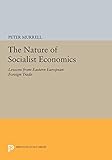The Nature of Socialist Economics : Lessons from Eastern European Foreign Trade / Peter Murrell.
Material type: TextSeries: Princeton Legacy Library ; 1061Publisher: Princeton, NJ : Princeton University Press, [2014]Copyright date: ©1990Edition: Course BookDescription: 1 online resource (292 p.)Content type:
TextSeries: Princeton Legacy Library ; 1061Publisher: Princeton, NJ : Princeton University Press, [2014]Copyright date: ©1990Edition: Course BookDescription: 1 online resource (292 p.)Content type: - 9780691606422
- 9781400860869
- 382/.0947 23
- online - DeGruyter
- Issued also in print.
| Item type | Current library | Call number | URL | Status | Notes | Barcode | |
|---|---|---|---|---|---|---|---|
 eBook
eBook
|
Biblioteca "Angelicum" Pont. Univ. S.Tommaso d'Aquino Nuvola online | online - DeGruyter (Browse shelf(Opens below)) | Online access | Not for loan (Accesso limitato) | Accesso per gli utenti autorizzati / Access for authorized users | (dgr)9781400860869 |
Frontmatter -- Contents -- List of Figures -- List of Tables -- Acknowledgments -- CHAPTER 1. An Overview of the Research, the Theories Underlying the Interpretation of the Results, and the Conclusions -- CHAPTER 2. The Variables Used in the Analysis: Their Properties and Sources of Data -- CHAPTER 3. International Trade Theory and the Centrally Planned Economies -- CHAPTER 4. Qualitative Information on Nonstandard Trade Determinants: Summary Statistics from Trade Data -- CHAPTER 5. The Econometrics of Estimating Endowments Implicit in Trade Decisions and Measuring Country Conformity to Trade Models -- CHAPTER 6. The Levels of Resource Endowments Implicit in Eastern European Trade Patterns: Estimates for Eleven Endowments -- CHAPTER 7. Measuring How Closely the Trade Patterns of Socialist and Capitalist Economies Fit Standard Trade Models -- EPILOGUE: The Results and Some Questions They Raise -- APPENDIX A: Do RCAs Reveal Comparative Advantage? -- APPENDIX B: Derivation of Equations Representing Trade Models -- APPENDIX C: Interpreting the Values of RCAs in the Presence of Intraindustry Trade -- APPENDIX D: Interpreting the Estimates in the Presence of Missing Data -- References -- Index
restricted access online access with authorization star
http://purl.org/coar/access_right/c_16ec
What are the sources of the well-known differences in the performance of capitalist and socialist economic systems? Peter Murrell argues that the Schumpeterian model has far more power to answer this question than does the neoclassical theory generally used for that purpose. The neoclassical theory focuses on the absence of a price system and the inability of a centralized system to allocate resources efficiently, while the Schumpeterian model emphasizes the rigidity of institutions and policies in socialist economies and their lack of mechanisms either to create new institutions or to identify and to foster the growth of the most efficient organizations (including multinational corporations). In a work that will have profound consequences for the analysis of economic reform in socialist economies, Murrell compares the predictions of these two models against data summarizing foreign trade performance and finds the Schumpeterian model clearly superior. Combining international trade theory and econometric techniques, the author develops new methods of comparative economic analysis. These methods provide new information on the values of eleven resource endowments implicit in trade, the degree to which the socialist countries fit standard models of trade, the effect of multinational corporations on trade, and myriad other features of economic performance.Originally published in 1990.The Princeton Legacy Library uses the latest print-on-demand technology to again make available previously out-of-print books from the distinguished backlist of Princeton University Press. These editions preserve the original texts of these important books while presenting them in durable paperback and hardcover editions. The goal of the Princeton Legacy Library is to vastly increase access to the rich scholarly heritage found in the thousands of books published by Princeton University Press since its founding in 1905.
Issued also in print.
Mode of access: Internet via World Wide Web.
In English.
Description based on online resource; title from PDF title page (publisher's Web site, viewed 30. Aug 2021)


